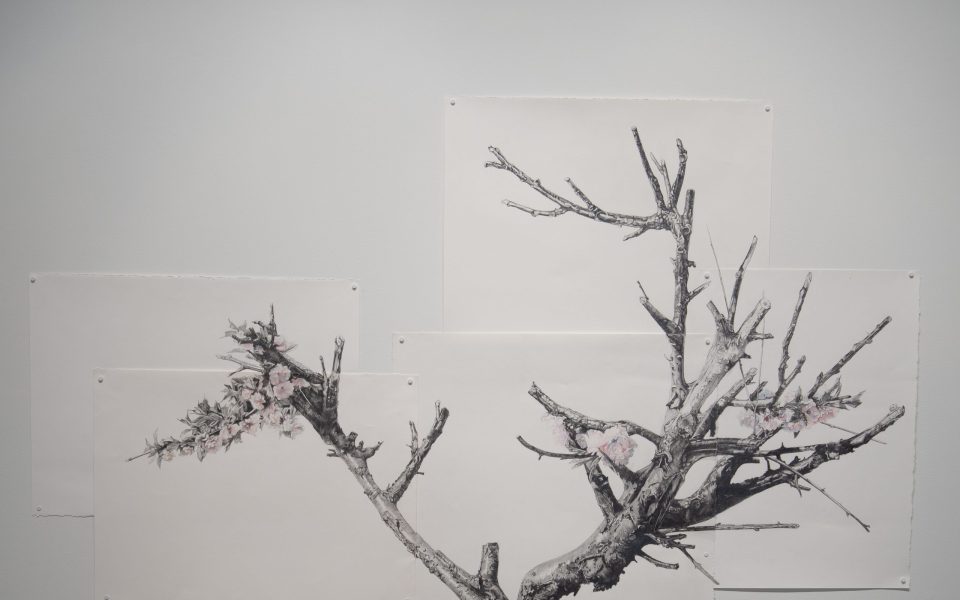“I use the whole spectrum of the pencils,” Christine Kirouac says. “And I know how to wield them.”
The artist scoured every inch of her home for any form of graphite. The search took her back to sets of mechanical and gold wooden pencils from high school, through the full range of hard and soft leads in artist-grade tools.
The finished work, The Same Leaving: Three Projects by Christine Kirouac, opened at the Southeastern Center for Contemporary Art in Winston-Salem on Jan. 17.
The exhibit fills the Potter Gallery with an audio/video installation and two series of graphite pieces. Titled “Les Feuilles Mortel” or “Deadly Leaves,” “State Lines” and “After Winter, Before Spring,” they explore the feelings surrounding different types of departure.
Kirouac understands the titular theme of leaving as an emotional and physical process. Though the experience of leaving is universal, Kirouac focuses on her personal life. The artist names North Carolina, Winnipeg, Montreal and San Francisco as her “quasi-homes.” She travels further back in the timeline, speaking of her adoption as “the initial leaving” — a moment that follows her.
“I always think with adoption it’s this double-sided coin,” she says. “You were left, but you were chosen at the same time by others; but they’re always intrinsically connected.”
Graduate school in Montreal inspired Kirouac to create “State Lines,” her earliest project in the exhibit. The audio and video installation made in 2005 displays a pair of looping films depicting pipes in the city’s subway tunnels. The pipes seem ghostly instead of solid metal, blurred from the motion of the camera. The everlasting lines projected onto the walls turn the gallery into a liminal space of transit.
“I’m much more interested in the grayscale,” says Kirouac about her process.
The mindset reflects the nature of the artist’s graphite work, with a spectrum of grays depicting the complexities of otherwise familiar images of the outdoors. The skeletons of trees or the dense brush of kudzu contrast starkly against the light paint on the gallery wall.
The two pencil projects, “Les Feuilles Mortel” and “After Winter, Before Spring,” found their medium from the amount of detail Kirouac could capture with graphite, and the visceral practice of drawing.
“Drawing historically is, I think, the closest connection between what an artist is thinking and feeling, and the paper,” Kirouac says. “It’s one of the most immediate responses an artist can have to any given inspiration.”
The distinct environments of North Carolina and Winnipeg influence the works. Though she physically had left both areas, she mentally stepped between the two, finding subject matter in the natural habitats of both. She would hold onto the images found in moments alone during walks through neighborhoods and forests, and recreate them with pencil on paper, no matter how brutal the scene. The sight of kudzu slowly constricting another structure. Bodies of birds partially devoured by other wildlife, only the wings left behind.
Kirouac sees a crow and draws its body catatonic, wings flush against its body. The feet of the bird move to another page, the two sheets connected at a corner. Kirouac transforms the common sight of a naked tree into a lanky figure sprawling out across two pages. The skinny trunk curves like a hunched-over spine, with branches hanging low towards the ground. Without leaves, the knots on each limb lay uncovered. The shine of her pencil ricochets off a thick wall of kudzu spread across a blanket of paper, a section of which sports a streak of pink among the dark slate gray.
The framing of many ordinary images makes Kirouac’s process seem like a dissection. The only other color in the graphite drawings belongs to a set of flowers blooming on an otherwise bare tree. Despite stretching across five sheets, parts of the tree’s trunk and branches remain unshown.
“Maybe each tree is me,” Kirouac said. “They’re probably self-portraits.”
Join the First Amendment Society, a membership that goes directly to funding TCB‘s newsroom.
We believe that reporting can save the world.
The TCB First Amendment Society recognizes the vital role of a free, unfettered press with a bundling of local experiences designed to build community, and unique engagements with our newsroom that will help you understand, and shape, local journalism’s critical role in uplifting the people in our cities.
All revenue goes directly into the newsroom as reporters’ salaries and freelance commissions.


Leave a Reply